Estimating SDG Indicators in Data-Scarce Areas: The Transition to the Use of New Technologies and Multidisciplinary Studies
Abstract
1. Introduction
2. Materials and Methods
2.1. Identifying the Need—Selecting SDG Indicators
- SDG 15: Life on Land: Protect, restore and promote sustainable use of terrestrial ecosystems, sustainably manage forests, combat desertification, and halt and reverse land degradation and halt biodiversity loss.Target 15.3: Land Degradation Neutrality (LDN): By 2030, combat desertification, restore degraded land and soil, including land affected by desertification, drought and floods, and strive to achieve a land degradation neutral world. Achieving LDN will require avoiding or reducing new degradation and restoring and rehabilitating lands that were degraded in the past.Indicator 15.3.1: Proportion of land that is degraded over total land area. It aims to maintain or improve the sustainable delivery of ecosystem services; maintain or improve productivity, in order to enhance food security; increase resilience of the land and populations dependent on the land; seek synergies with other social, economic and environmental objectives; reinforce responsible and inclusive governance of land.
- SDG 11: Sustainable Cities and Communities, refers to inclusive, safe, resilient and sustainable cities and human settlements. In the same way as living organisms, cities evolve, transform, adapt, innovate and change with emerging trends.Target 11.3: By 2030, enhance inclusive and sustainable urbanization and capacities for participatory, integrated and sustainable human settlement planning and management in all countries.Indicator 11.3.1: rate at which cities are expanding spatially versus the rate their population is growing. It aims to understand urban transition dynamics, enhance the study of the speed of growth for different settlements, the direction and type of growth. Understanding growth can help estimate demand for services, direct investments; support development of policies for sustainable urbanisation; support vulnerability assessment and disaster preparedness/response.
2.2. Indicator 15.3.1
- Land Productivity: Τhe biological productive capacity of the land, the source of all the food, fiber and fuel that sustains humans. It is assessed through the NPP.NPP is the net amount of carbon assimilated after photosynthesis and autotrophic respiration over a given period of time and is typically represented in units such as kg/ha/yr [21]. In satellite imagery, NPP is assessed by the NDVI (Net Difference of Vegetation Index), which is estimated as the ratio of the “green-reflection” (healthy—higher NDVI) vegetation to the “red- reflection” (stressed—lower NDVI) vegetation. These increases or decreases in the NDVI is the metric used to evaluate the land productivity changes over time [22].
- Land Cover Change: This describes changes in the observed biophysical character of the earth’s surface to help identify areas that may be subject to change. A transition from one land cover type to another may be considered an improvement, a neutral change or degradation, depending on the perspective of the country in question. The procedure followed was to use satellite data from different years, estimate the changes and, according to the transition criteria (Figure 1), estimate the potential land degradation map. This takes into account the various land cover types and assigns a positive, negative or neutral state for each possible change (this is the evaluation metric).
- Carbon Stocks: Above and Below Ground Carbon (Soil Organic C)Carbon stocks reflect the integration of multiple processes affecting plant growth and the gains and losses from terrestrial organic matter pools. The metric used to assess carbon stocks adopted for Indicator 15.3.1 is soil organic carbon (SOC). For this, an initial measure of SOC and a time series of land cover change are needed. The data from a time series of land cover for the selected area were used to estimate the land cover change over the examined time period. The change in SOC stocks compared to the initial baseline value was estimated using the conversion factors of Figure 2 (Table), which evaluate the land cover changes in terms of C stock change. With the use of remote sensing data these calculations are performed for each pixel of the map of the area of interest. Reduction of SOC greater than 10% indicates a degradation.
2.3. Indicator 11.3.1
2.4. Tools and Data
2.5. Towards the Integration of Database Capacity into Applicable Models and Tools
3. Results
3.1. SDG15.3.1
3.2. Indicator SDG11.3.1
3.3. Towards an Integrated Approach
- understand the environmental components (air, atmosphere, land, soil, water) and their interactions or cause–effect relations (becoming conscious);
- model them with environmental and engineering models that will provide a detailed catchment characterisation, assess and optimise the different measures, and support the decision-making process;
- provide scientific and committed stakeholder analysis (parallel process) with continuous feedback for the decision making (co-design common long-run visions) and measures’ implementation;
- provide continuous progress tracking (inspection and re-feeding the described loop).
4. Discussion
5. Conclusions
Author Contributions
Funding
Institutional Review Board Statement
Informed Consent Statement
Data Availability Statement
Acknowledgments
Conflicts of Interest
References
- UN. A New Global Partnership: Eradicate Poverty and Transform Economies through Sustainable Development. 2013. Available online: https://sustainabledevelopment.un.org/index.php?page=view&type=400&nr=893&menu=35 (accessed on 10 July 2021).
- UN. Agenda 2030 ‘to-Do List for People and Planet’, Secretary-General Tells World Leaders Ahead of Adoption. UN Press Release. 2015. Available online: https://www.un.org/press/en/2015/sgsm17111.doc.htm (accessed on 10 July 2021).
- UN. Resolution Adopted by the General Assembly on 25 September 2015: 70/1 Transforming Our World: The 2030 Agenda for Sustainable Development. 2015. Available online: https://www.un.org/en/development/desa/population/migration/generalassembly/docs/globalcompact/A_RES_70_1_E.pdf (accessed on 10 July 2021).
- Schmieg, E. External Trade Policy and the Sustainable Development Goals. Implementing the SDGs Will Meet Justified Criticisms of Globalisation. SWP Comments 2017, 39, 5. [Google Scholar]
- Spangenberg, J.H. Hot Air or Comprehensive Progress? A Critical Assessment of the SDGs. Sustain. Dev. 2017, 25, 311–321. [Google Scholar] [CrossRef]
- MacFeely, S. Measuring the Sustainable Development Goals: What Does It Mean for Ireland? Administration 2017, 65, 41–71. [Google Scholar] [CrossRef][Green Version]
- McGrath, L.; Hynes, S.; McHale, J. Linking Sustainable Development Assessment in Ireland and the European Union with Economic Theory. Econ. Soc. Rev. 2020, 51, 327–355. [Google Scholar]
- DCCAE (Department of Communications, Climate Action & Environment). The Sustainable Development Goals National Implementation Plan 2018–2020; DCCAE: Dublin, Ireland, 2020; p. 136.
- Social Justice Ireland Ireland Ranks 11th out of 15 EU Countries on UN Sustainable Development Goals|Social Justice Ireland. Available online: https://www.socialjustice.ie/content/policy-issues/ireland-ranks-11th-out-15-eu-countries-un-sustainable-development-goals (accessed on 5 June 2021).
- EPA. Charting Ireland’s Sustainable Future: Innovative Approaches towards Achieving the United Nations Sustainable Development Goals for Enterprises; SDGs and Enterprise: Dublin, Ireland, 2020; p. 113. [Google Scholar]
- Paganini, M.; Petiteville, I.; Ward, S.; Dyke, G.; Steventon, M.; Harry, J.; Kerblat, F. Satellite Earth Observations in Support of the Sustainable Development Goals: The CEOS Earth Observation Handbook; The Committee on Earth Observation Satellites and the European Space Agency: Paris, France, 2018. [Google Scholar]
- Giuliani, G.; Mazzetti, P.; Santoro, M.; Nativi, S.; Van Bemmelen, J.; Colangeli, G.; Lehmann, A. Knowledge Generation Using Satellite Earth Observations to Support Sustainable Development Goals (SDG): A Use Case on Land Degradation. Int. J. Appl. Earth Obs. Geoinf. 2020, 88, 102068. [Google Scholar] [CrossRef]
- Mulligan, M.; van Soesbergen, A.; Hole, D.G.; Brooks, T.M.; Burke, S.; Hutton, J. Mapping Nature’s Contribution to SDG 6 and Implications for Other SDGs at Policy Relevant Scales. Remote Sens. Environ. 2020, 239, 111671. [Google Scholar] [CrossRef]
- Watmough, G.R.; Marcinko, C.L.J.; Sullivan, C.; Tschirhart, K.; Mutuo, P.K.; Palm, C.A.; Svenning, J.-C. Socioecologically Informed Use of Remote Sensing Data to Predict Rural Household Poverty. Proc. Natl. Acad. Sci. USA 2019, 116, 1213–1218. [Google Scholar] [CrossRef] [PubMed]
- Estoque, R.C. A Review of the Sustainability Concept and the State of SDG Monitoring Using Remote Sensing. Remote Sens. 2020, 12, 1770. [Google Scholar] [CrossRef]
- Varotsos, C.A.; Cracknell, A.P. Remote Sensing Letters Contribution to the Success of the Sustainable Development Goals-UN 2030 Agenda. Remote Sens. Lett. 2020, 11, 715–719. [Google Scholar] [CrossRef]
- Teich, I.; Gonzalez Roglich, M.; Corso, M.L.; García, C.L. Combining Earth Observations, Cloud Computing, and Expert Knowledge to Inform National Level Degradation Assessments in Support of the 2030 Development Agenda. Remote Sens. 2019, 11, 2918. [Google Scholar] [CrossRef]
- Ishtiaque, A.; Masrur, A.; Rabby, Y.W.; Jerin, T.; Dewan, A. Remote Sensing-Based Research for Monitoring Progress towards SDG 15 in Bangladesh: A Review. Remote Sens. 2020, 12, 691. [Google Scholar] [CrossRef]
- Kelly-Quinn, M.; Christie, M.; Bodoque, J.M.; Schoenrock, K. Ecosystem Services Approach and Natures Contributions to People (NCP) Help Achieve SDG6. In Clean Water and Sanitation; Leal Filho, W., Azul, A.M., Brandli, L., Lange Salvia, A., Wall, T., Eds.; Springer International Publishing: Cham, Germany, 2020; pp. 1–13. ISBN 978-3-319-70061-8. [Google Scholar]
- United Nations. The 17 Goals|Sustainable Development. Available online: https://sdgs.un.org/goals (accessed on 26 February 2021).
- Clark, D.A.; Brown, S.; Kicklighter, D.W.; Chambers, J.Q.; Thomlinson, J.R.; Ni, J. Measuring Net Primary Production in Forests: Concepts and Field Methods. Ecol. Appl. 2001, 11, 356–370. [Google Scholar] [CrossRef]
- Trends.Earth—Trends.Earth 1.0.4 Documentation. Available online: https://trends.earth/docs/en/index.html (accessed on 9 July 2021).
- Trends.Earth Urban Mapper. Available online: https://geflanddegradation.users.earthengine.app/view/trendsearth-urban-mapper (accessed on 9 July 2021).
- De Colstoun, E.C.B.; Huang, C.; Wang, P.; Tilton, J.C.; Tan, B.; Phillips, J.; Niemczura, S.; Ling, P.-Y.; Wolfe, R.E. Global Man-Made Impervious Surface (GMIS) Dataset From Landsat 2017. Available online: https://sedac.ciesin.columbia.edu/data/set/ulandsat-gmis-v1 (accessed on 10 July 2021).
- Alamanos, A.; Linnane, S. Towards a Unifying Framework for Balancing Different SDGs and Objectives, and Achieving Sustainability: New Technologies, Socio-Hydrology, and Multi-Disciplinarity in Data-Scarce Areas. In Proceedings of the 1st Socio-Hydrology Conference, Delft, The Netherlands, 6–8 September 2021. [Google Scholar]
- NASA. Earth Observations (NEO). Available online: https://neo.sci.gsfc.nasa.gov/ (accessed on 9 July 2021).
- Devaney, J.; Barrett, B.; Barrett, F.; Redmond, J.; O’Halloran, J. Forest Cover Estimation in Ireland Using Radar Remote Sensing: A Comparative Analysis of Forest Cover Assessment Methodologies. PLoS ONE 2015, 10, e0133583. [Google Scholar] [CrossRef] [PubMed]
- Wilson, J.; Coxon, C.; Rocha, C. A GIS and Remote Sensing Based Screening Tool for Assessing the Potential for Groundwater Discharge to Lakes in Ireland. Biol. Environ. Proc. R. Ir. Acad. 2016, 116, 265–277. [Google Scholar] [CrossRef]
- Wilson, J.; Rocha, C. A Combined Remote Sensing and Multi-Tracer Approach for Localising and Assessing Groundwater-Lake Interactions. Int. J. Appl. Earth Obs. Geoinf. 2016, 44, 195–204. [Google Scholar] [CrossRef]
- Verbeiren, B.; Van De Voorde, T.; Canters, F.; Binard, M.; Cornet, Y.; Batelaan, O. Assessing Urbanisation Effects on Rainfall-Runoff Using a Remote Sensing Supported Modelling Strategy. Int. J. Appl. Earth Obs. Geoinf. 2013, 21, 92–102. [Google Scholar] [CrossRef]
- Ali, I.; Cawkwell, F.; Dwyer, E.; Green, S. Modeling Managed Grassland Biomass Estimation by Using Multitemporal Remote Sensing Data—A Machine Learning Approach. IEEE J. Sel. Top. Appl. Earth Obs. Remote Sens. 2017, 10, 3254–3264. [Google Scholar] [CrossRef]
- Jordan, C.J. An Holistic Approach to Mapping the Quaternary Geology and Reconstructing the Last Glaciation of West County Mayo, Ireland, Using Satellite Remote Sensing and “conventional” Mapping Techniques. Ph.D. Thesis, Queen Mary University of London, London, UK, March 2002. [Google Scholar]
- Preißler, J.; Martucci, G.; Saponaro, G.; Ovadnevaite, J.; Vaishya, A.; Kolmonen, P.; Ceburnis, D.; Sogacheva, L.; de Leeuw, G.; O’Dowd, C. Six Years of Surface Remote Sensing of Stratiform Warm Clouds in Marine and Continental Air over Mace Head, Ireland. J. Geophys. Res. Atmos. 2016, 121, 14538–14557. [Google Scholar] [CrossRef]
- Agarwal, A.; Taveneau, A.; Olbert, I.A. Remote Sensing of Surface Waters in Ireland. In Proceedings of the 2018 CERI, University College Dublin, Dublin, Ireland, 29–30 August 2018; p. 7. [Google Scholar]
- Ireland’s Hub for Sustainable Development Goals. Available online: https://irelandsdg.geohive.ie/ (accessed on 9 July 2021).
- FAO. Statistical Capacity Country Profile for SDG Indicators (Ireland): Statistical Capacity Assessment for the FAO-Relevant SDG Indicators 2018/19; FAO: Rome, Italy, 2019. [Google Scholar]
- McCormack, K.; Smyth, M. Road Map on Statistics for Sustainable Development Goals: A Review of Ireland’s Implementation of the Recommendations from the Conference of European Statisticians; Central Statistics Office, Ireland: Dublin, Ireland, 2019; p. 14. [Google Scholar]
- Database Tools-CSO-Central Statistics Office. Available online: https://www.cso.ie/en/databases/databasetools/ (accessed on 9 July 2021).
- Alamanos, A.; Rolston, A.; Linnane, S. Irish Bathing Sites Closures and Stormwater Overflows: Precipitation Forecasts, Extremes Analysis, and Comparison with Climate Change Projections. In Proceedings of the EGU General Assembly 2021, Copernicus Meetings, Online, 3 March 2021. [Google Scholar]
- Irish Water. National Water Resources Plan–Framework Plan; Irish Water’s 25 Year Plan for Our Water Assets; Irish Water: Dublin, Ireland, 2021; p. 184. [Google Scholar]
- An Fóram Uisce. Available online: https://thewaterforum.ie/ (accessed on 9 July 2021).
- Alamanos, A.; Rolston, A.; Papaioannou, G. Development of a Decision Support System for Sustainable Environmental Management and Stakeholder Engagement. Hydrology 2021, 8, 40. [Google Scholar] [CrossRef]
- The Water Forum. A Framework for Integrated Land and Landscape Management: Protecting and Enhancing Our Environment; An Fóram Uisce: Tipperary, Ireland, 2021; p. 36. [Google Scholar]
- Natural Earth-Free Vector and Raster Map Data at 1:10 m, 1:50 m, and 1:110 m Scales. Available online: https://www.naturalearthdata.com/ (accessed on 7 July 2021).
- Department of Housing, Planning and Local Government. River Basin Management Plan for Ireland 2018–2021; Government of Ireland: Dublin, Ireland, 2017.
- McManus, S.-L.; Coxon, C.E.; Mellander, P.-E.; Danaher, M.; Richards, K.G. Hydrogeological Characteristics Influencing the Occurrence of Pesticides and Pesticide Metabolites in Groundwater across the Republic of Ireland. Sci. Total Environ. 2017, 601, 594–602. [Google Scholar] [CrossRef] [PubMed]
- Graves, A.R.; Morris, J.; Deeks, L.K.; Rickson, R.J.; Kibblewhite, M.G.; Harris, J.A.; Farewell, T.S.; Truckle, I. The Total Costs of Soil Degradation in England and Wales. Ecol. Econ. 2015, 119, 399–413. [Google Scholar] [CrossRef]
- Aherne, J.; Alonso, M.; Araújo, C.; Arias-González, A.; Bakker, M.; Bansept, A.; Barros, N.; Bechevet, B.; Black, H.; Booth, P.; et al. Soil Degradation Risks in Planted Forests; Servicio Central de Publicaciones del Gobierno Vasco: Gasteiz, Spain, 2015. [Google Scholar]
- Conroy, E.; Turner, J.N.; Rymszewicz, A.; O’Sullivan, J.J.; Bruen, M.; Lawler, D.; Lally, H.; Kelly-Quinn, M. The Impact of Cattle Access on Ecological Water Quality in Streams: Examples from Agricultural Catchments within Ireland. Sci. Total Environ. 2016, 547, 17–29. [Google Scholar] [CrossRef] [PubMed]
- Schulte, R.P.O.; Richards, K.; Daly, K.; Kurz, I.; McDonald, E.J.; Holden, N.M. Agriculture, meteorology and water quality in Ireland: A regional evaluation of pressures and pathways of nutrient loss to water. Biol. Environ. Proc. R. Ir. Acad. 2006, 106, 117–133. [Google Scholar] [CrossRef]
- Jess, S.; Kildea, S.; Moody, A.; Rennick, G.; Murchie, A.K.; Cooke, L.R. European Union Policy on Pesticides: Implications for Agriculture in Ireland. Pest Manag. Sci. 2014, 70, 1646–1654. [Google Scholar] [CrossRef] [PubMed]
- O’Boyle, S. Water Quality in Ireland 2013–2018. In Proceedings of the Irish Freshwater Science Association, Online, 6 March 2020. [Google Scholar]
- Population Distribution-CSO-Central Statistics Office. Available online: https://www.cso.ie/en/releasesandpublications/ep/p-cp2tc/cp2pdm/pd/ (accessed on 9 July 2021).
- 30 Year Averages-Met Éireann-The Irish Meteorological Service. Available online: https://www.met.ie/climate/30-year-averages (accessed on 9 July 2021).
- Keegan, M.; Kilroy, K.; Nolan, D.; Dubber, D.; Johnston, P.M.; Misstear, B.D.R.; O’Flaherty, V.; Barrett, M.; Gill, L.W. Assessment of the Impact of Traditional Septic Tank Soakaway Systems on Water Quality in Ireland. Water Sci. Technol. 2014, 70, 634–641. [Google Scholar] [CrossRef]
- Prince, S.D. Challenges for Remote Sensing of the Sustainable Development Goal SDG 15.3.1 Productivity Indicator. Remote Sens. Environ. 2019, 234, 111428. [Google Scholar] [CrossRef]
- Gennari, P.; Navarro, D.K. Validation of Methods and Data for SDG Indicators. Stat. J. IAOS 2019, 35, 735–741. [Google Scholar] [CrossRef]
- Hakimdavar, R.; Hubbard, A.; Policelli, F.; Pickens, A.; Hansen, M.; Fatoyinbo, T.; Lagomasino, D.; Pahlevan, N.; Unninayar, S.; Kavvada, A.; et al. Monitoring Water-Related Ecosystems with Earth Observation Data in Support of Sustainable Development Goal (SDG) 6 Reporting. Remote Sens. 2020, 12, 1634. [Google Scholar] [CrossRef]
- Fehri, R.; Khlifi, S.; Vanclooster, M. Disaggregating SDG-6 Water Stress Indicator at Different Spatial and Temporal Scales in Tunisia. Sci. Total Environ. 2019, 694, 133766. [Google Scholar] [CrossRef]
- Ovienmhada, U.; Wood, D.; Mouftaou, F.; Badou, F.D.; Djihouessi, B.; Lagomasino, D.; Fatoyinbo, T.; Ashcroft, E.; Lombardo, S.; Jiang, M. Earth Observation Technology Applied to SDG 15.8 in West Africa: Multi-Data Stream Analysis and Validation Approaches. In Proceedings of the 2020 AGU Fall Meeting, Online, 1–17 December 2020; p. SY006-04. [Google Scholar]
- Wang, Y.; Huang, C.; Feng, Y.; Zhao, M.; Gu, J. Using Earth Observation for Monitoring SDG 11.3.1-Ratio of Land Consumption Rate to Population Growth Rate in Mainland China. Remote Sens. 2020, 12, 357. [Google Scholar] [CrossRef]
- Aquilino, M.; Tarantino, C.; Adamo, M.; Barbanente, A.; Blonda, P. Earth Observation for the Implementation of Sustainable Development Goal 11 Indicators at Local Scale: Monitoring of the Migrant Population Distribution. Remote Sens. 2020, 12, 950. [Google Scholar] [CrossRef]
- Holloway, J.; Mengersen, K.; Helmstedt, K. Spatial and machine learning methods of satellite imagery analysis for Sustainable Development Goals. In Proceedings of the 16th Conference of International Association for Official Statistics (IAOS); International Association for Official Statistics (IAOS): Paris, France, 2018; pp. 1–14. [Google Scholar]
- Lovelace, R.; Nowosad, J.; Muenchow, J. Geocomputation with R; CRC Press, Taylor and Francis Group: Boca Raton, FL, USA, 2021; Available online: https://geocompr.robinlovelace.net/ (accessed on 4 September 2021)ISBN 978-1138304512.
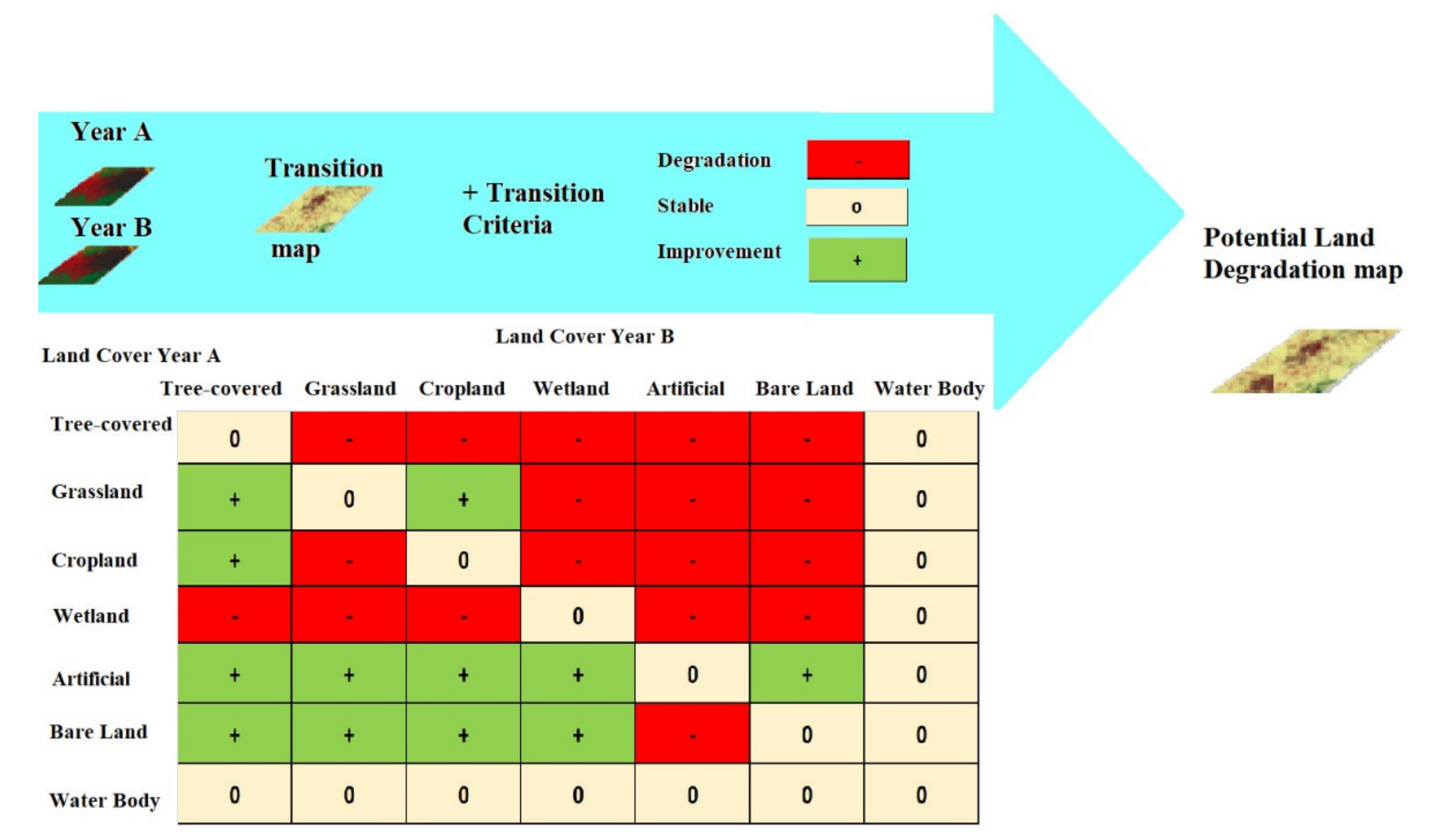
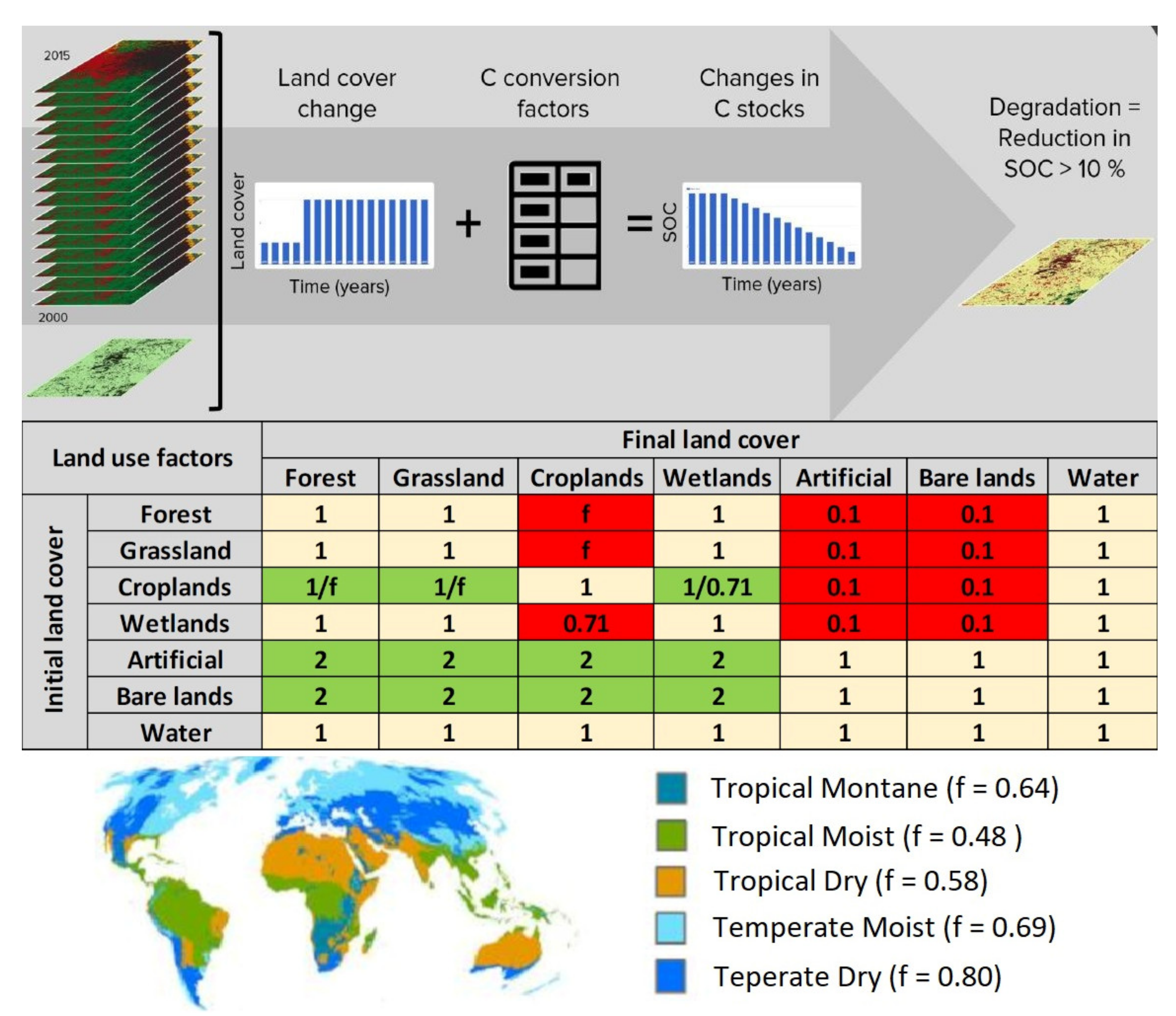

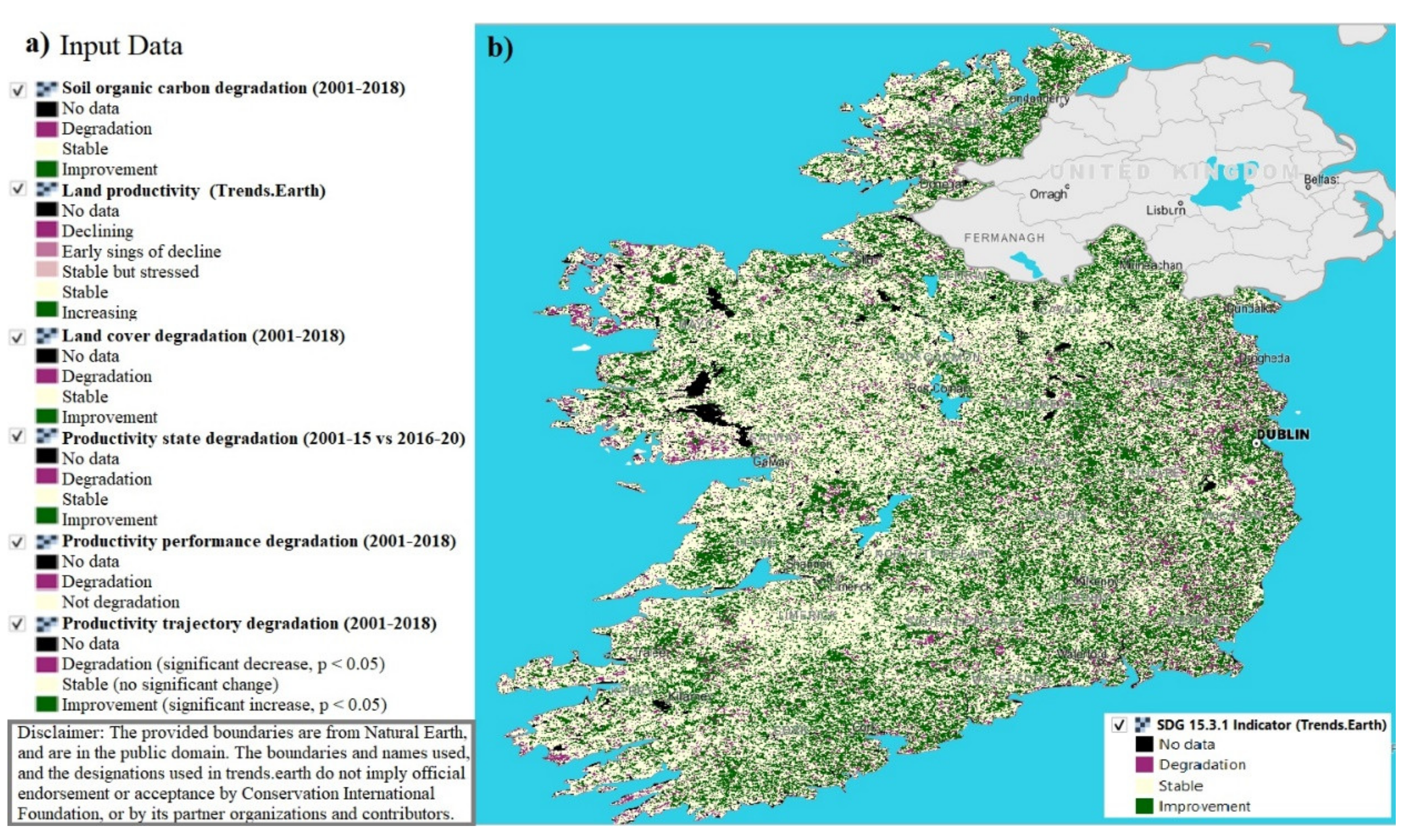
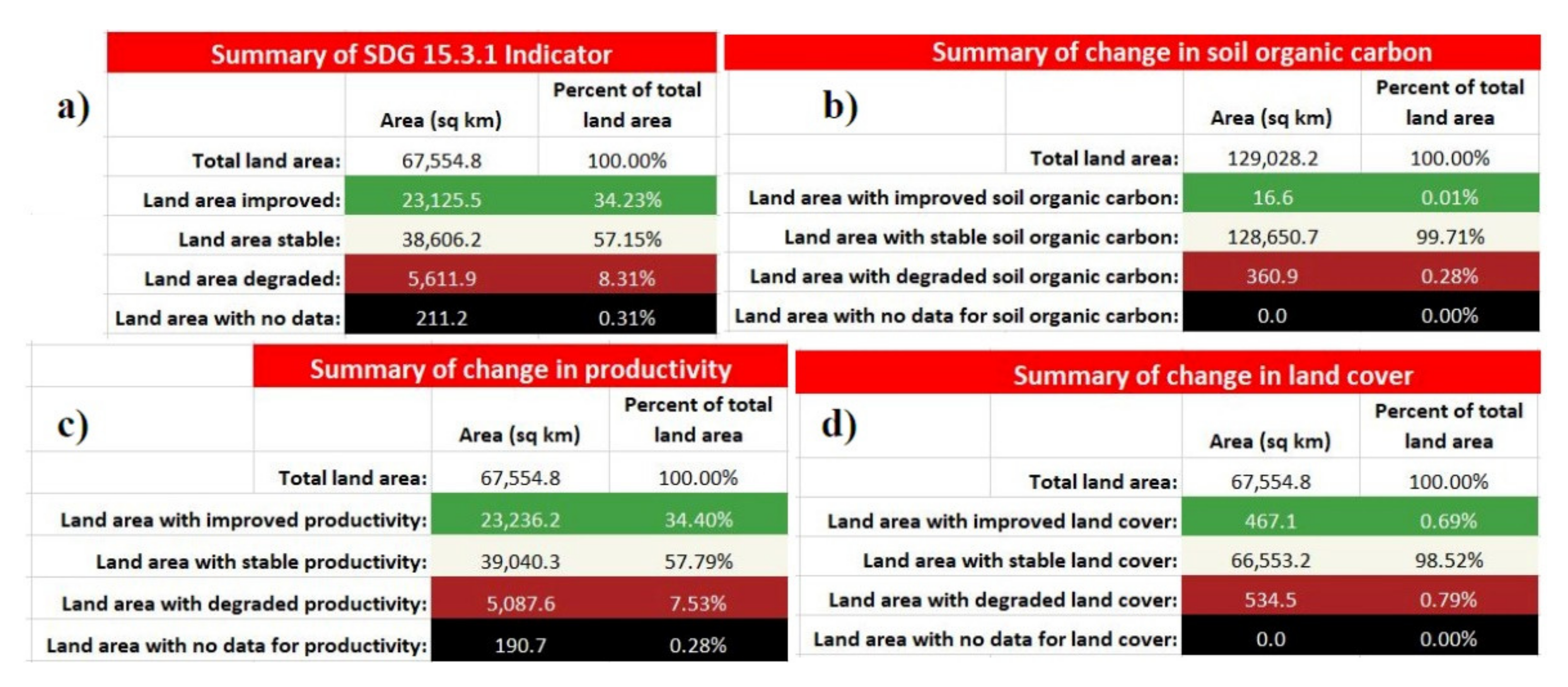
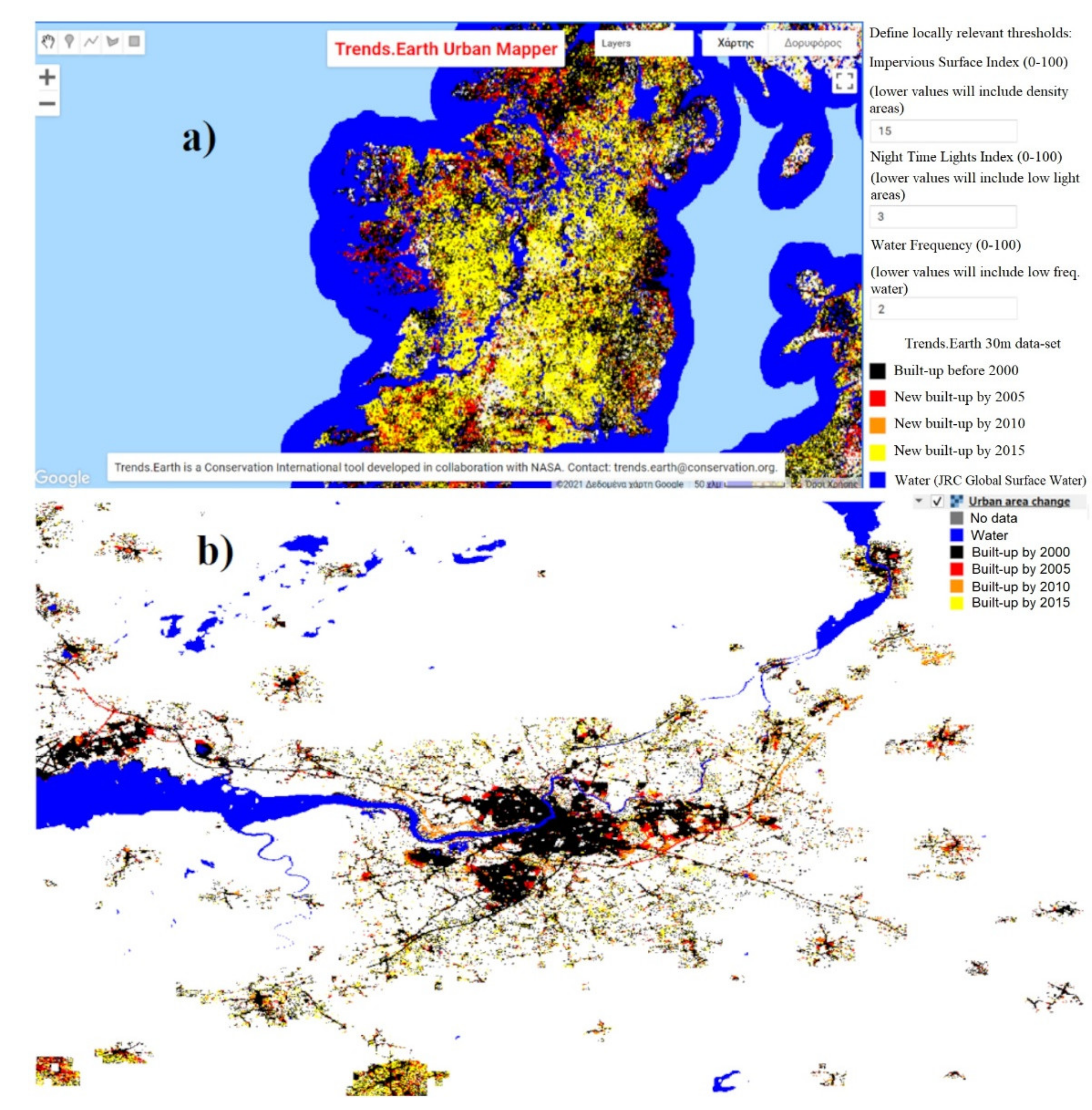
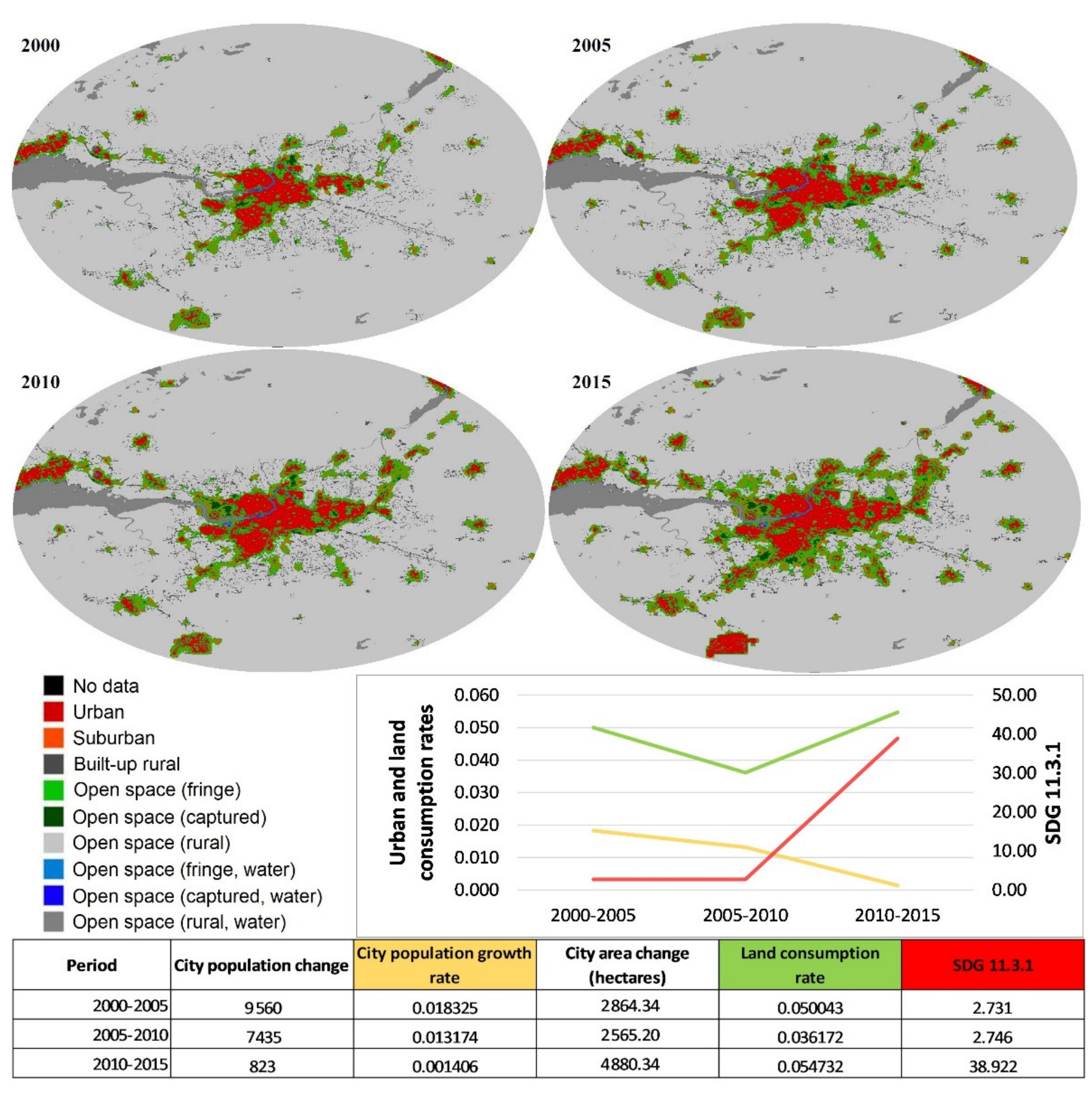
| Productivity | Land Cover | SOC | Output: SDG15.3.1 |
|---|---|---|---|
| Improving | Improving | Improving | Improving |
| Improving | Improving | Stable | Improving |
| Improving | Improving | Declining | Declining |
| Improving | Stable | Improving | Improving |
| Improving | Stable | Stable | Improving |
| Improving | Stable | Declining | Declining |
| Improving | Declining | Improving | Declining |
| Improving | Declining | Stable | Declining |
| Improving | Declining | Declining | Declining |
| Stable | Improving | Improving | Improving |
| Stable | Improving | Stable | Improving |
| Stable | Improving | Declining | Declining |
| Stable | Stable | Improving | Improving |
| Stable | Stable | Stable | Stable |
| Stable | Stable | Declining | Declining |
| Stable | Declining | Improving | Declining |
| Stable | Declining | Stable | Declining |
| Stable | Declining | Declining | Declining |
| Declining | Improving | Improving | Declining |
| Declining | Improving | Stable | Declining |
| Declining | Improving | Declining | Declining |
| Declining | Stable | Improving | Declining |
| Declining | Stable | Stable | Declining |
| Declining | Stable | Declining | Declining |
| Declining | Declining | Improving | Declining |
Publisher’s Note: MDPI stays neutral with regard to jurisdictional claims in published maps and institutional affiliations. |
© 2021 by the authors. Licensee MDPI, Basel, Switzerland. This article is an open access article distributed under the terms and conditions of the Creative Commons Attribution (CC BY) license (https://creativecommons.org/licenses/by/4.0/).
Share and Cite
Alamanos, A.; Linnane, S. Estimating SDG Indicators in Data-Scarce Areas: The Transition to the Use of New Technologies and Multidisciplinary Studies. Earth 2021, 2, 635-652. https://doi.org/10.3390/earth2030037
Alamanos A, Linnane S. Estimating SDG Indicators in Data-Scarce Areas: The Transition to the Use of New Technologies and Multidisciplinary Studies. Earth. 2021; 2(3):635-652. https://doi.org/10.3390/earth2030037
Chicago/Turabian StyleAlamanos, Angelos, and Suzanne Linnane. 2021. "Estimating SDG Indicators in Data-Scarce Areas: The Transition to the Use of New Technologies and Multidisciplinary Studies" Earth 2, no. 3: 635-652. https://doi.org/10.3390/earth2030037
APA StyleAlamanos, A., & Linnane, S. (2021). Estimating SDG Indicators in Data-Scarce Areas: The Transition to the Use of New Technologies and Multidisciplinary Studies. Earth, 2(3), 635-652. https://doi.org/10.3390/earth2030037





